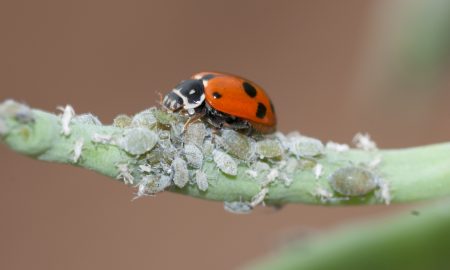With the help of agronomists and growers, we are keeping an eye on native budworm (Helicoverpa punctigera) moth activity over late winter and spring with pheromone traps.
Native budworm moths are capable of migrating hundreds if not thousands of kilometres in winter and spring. Typically, moths migrate into the cropping zone from the north or north-west, often originating from arid, inland regions.
When they arrive in agricultural regions, they fly rapidly from plant to plant throughout the night in a darting motion, feeding and laying eggs.
It is the larvae stage that is problematic in broadleaf crops, and they are at their most damaging when they feed on the fruiting parts and seeds of plants.
Moth trapping program
From early August, pheromone traps have been set up alongside pulse and canola crops at locations throughout south-eastern Australia.
The timing (and size) of moth catches indicate when egg-laying is likely to commence, and when crop monitoring should start.
So far traps have been set-up in:
Ouyen, Swan Hill and Kerang (Victorian Mallee)
Rupanyup, Marnoo, Laharum (Victorian Wimmera)
Deniliquin (Riverina NSW)
Moths have been detected at all seven locations throughout August, with the highest numbers in the Victorian Mallee, where weekly catches have reached ~180 moths (see moth data here).
Monitor for larvae
Growers and advisers should start to monitor pulses and canola with sweep net for larval activity.
Some larvae have already been detected in New South Wales. In the central west slopes and plains near Condobolin, native budworm larvae were found damaging an establishing linseed crop.
Near Rannock in the Riverina, young larvae have been reported in a faba bean crop and are likely to be native budworm.
Native budworm larvae vary in colour between shades of brown, green and orange and grow to around 40 mm.
While they usually have darkish stripes along the body and bumpy skin with sparse, stiff, stout hairs, these features can be less obvious in younger larvae.

Don’t hesitate to use our identification service if you’re unsure about the identity of native budworm (and other crop insects).
With the help of a model, we can also use larval growth stage to predict when populations are anticipated to do most of their damage.
For more information, including economic thresholds and management, visit our native budworm PestNote.
Acknowledgements
Field reports
Brad Bennett – AGRIvision (Mallee VIC)
Adam Dellwo – Elders (Riverina NSW)
Rob Fox – AGRIvision (Wimmera VIC)
Bill Gardner (Wimmera VIC)
Shayn Healey – Crop Rite (Mallee VIC)
George Hepburn – Tylers Hardware & Rural Supplies (Wimmera VIC)
Damian Jones – Irrigated Cropping Council (Mallee VIC)
Helen McMillan – Central West Farming System (Central West Slopes and Plains NSW)
Megan Pearce – Landmark (Riverina NSW)
Cover image: Photo by Andrew Weeks, Cesar Australia





